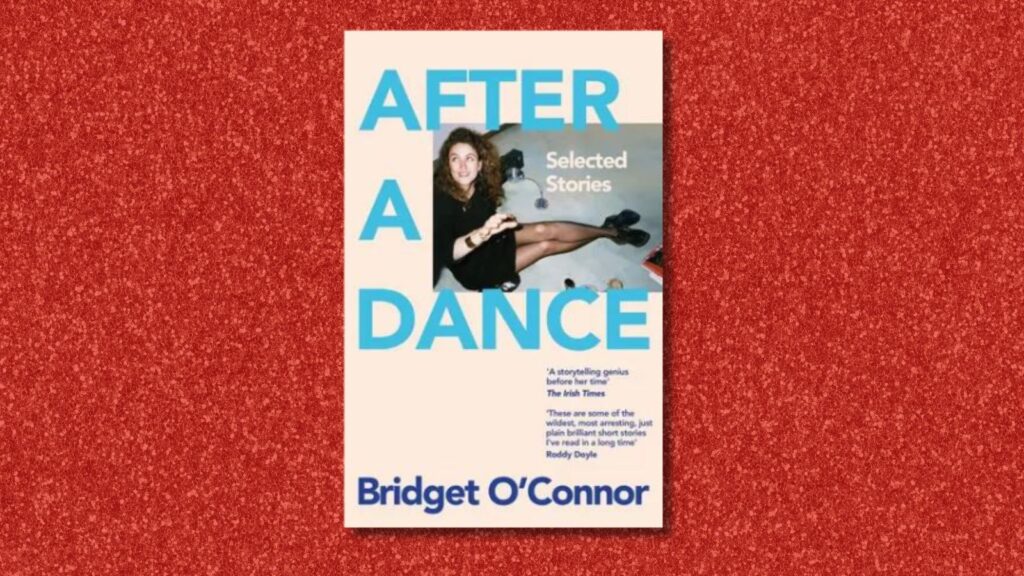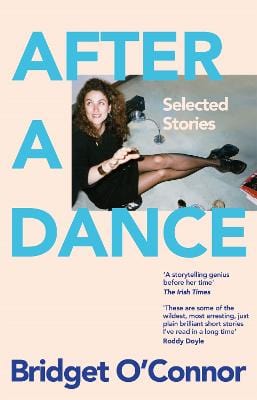
After a Dance|Bridget O’Connor|Pan MacMillan
“These fifteen stories have so much movement through the streets, it’s like being on a road trip.”
Rosemary Jenkinson reviews After a Dance, by Bridget O’Connor
An interviewer once described Bridget O’Connor (1961-2010) as “disarmingly if disconcertingly frank.” Nothing could be truer. I bumped into her on the Newcastle-upon-Tyne Metro one day and told her I was about to teach in Warsaw for a year.
“Nightmare,” she said succinctly.
Her reaction played on my mind so much, I went to teach in France instead.
Luckily for me, I’d wandered onto Bridget’s short story course in 1997 in Newcastle. I’d always written but had never had anything published at that point and I devoured her first collection, Here Comes John, then went to the launch of Tell Her You Love Her. I was enamoured with the urban cool and staccato syncopated beat of her prose. Bridget in person was hip, leather-jacketed and easygoing with an unbelievably thick spray of brown hair.
After A Dance is a blistering selection of O’Connor’s short stories, intimately prefaced by her daughter. It crackles with firecracker prose and revels in the lowlife cast featuring drinkers, druggies, scammers, petty thieves, chat-up merchants and narcissistic teenagers. Things kick off edgily with “Love Jobs”: “Here’s Neville twitching like a vein.” It’s a story of alcoholics on the make who accidentally kill a dog, an act that immerses them in poignant contemplation of their lost loves. These fifteen stories have so much movement through the streets, it’s like being on a road trip.
“Heavy Petting” is a stylistic treat for all short story a-fish-ionados. It centres on Godfrey the goldfish and his efforts to survive within a family that descends into craziness. While the story is obsidian black, Godfrey is a ray of hope throughout: “He blew air kisses all day, puffed out silvery smoke rings…” The romanticism lures in the reader before being humorously undercut by images of “the miniature ginger whale” Godfrey going round and round in “an endless Uey”.
These fifteen stories have so much movement through the streets, it’s like being on a road trip
The titular story has a rural Irish simplicity to it, but typical of O’Connor, it includes an excruciatingly embarrassing bedroom scene: “The bed creaked. It seemed to her it creaked out of time with their movements.” The entire collection bristles with sex. “Nerve Endings” is a delightfully baroque incursion into the neurological pleasures of being touched. The female protagonist runs through boyfriends “with an astonishing gobbling passion” and discovers that her erogenous zones are constantly on the move, shifting, for instance, from her left elbow to the freckle in her eyebrow. The story reaches its ludicrous apogee at the moment she fakes death in order to feel her eyes closed by a nurse. In spite of the light delivery, there is vast depth of feeling in this story. It can be read as a celebration of carnal delight or as a commentary on our inability to be sexually satisfied.
A fresh youthful vigour underpins all these stories, making them timeless
O’Connor’s comedic skills are on full display in “Plastered” as she skewers the grotesquerie of Tony Wornel, the cliché-ridden stalker who is “really full of the possible”. The satire is almost forensic and the heartlessness is delicious. When the plaster cast is removed from Tony’s leg, it’s “all withered and scaly. Mum said it reminded her of me next to Helen in the incubator.” The observation is equally sharp in “Here Comes John” where a woman plots to fleece men of their wealth by using an array of psychological tricks: “I told him I love watching men eat. Martin loved that. Martin loved being called a man.” The fact that these ‘yup’ men habitually call women ‘birds’ testifies to the nineties setting, but the collection itself doesn’t feel dated. A fresh youthful vigour underpins all these stories, making them timeless.
The satire is almost forensic and the heartlessness is delicious
After A Dance’s outsiders ache and thrum with possibilities as yet unlived. The two male chums in “Old Times” worry about approaching forty, having achieved so little, but even though Rick’s “tears shone on his face like two twists of cellophane”, his drunken brotherhood with Len is wildly life-affirming. More drunken wastrels roam the parks in “Gabriel Ascending”. In “Kissing Time”, a young woman on the verge of losing her teeth lists all the men she’s ever kissed. The accretive impact heightens the sense of loss.
What particularly impresses about the writing is the viscerality
The stories often shine a spotlight on societal behaviour. “Remission” is the witty tale of Eric’s unhappy marriage to Lucy, a celebrity cancer victim who rakes in a fortune from her cancer cookbooks and exercise merch. Eric tries to bribe a jailbird friend Mick to murder her, but in the ultimate irony, his own sudden death allows Lucy to reinvent herself as a celebrity grief peddler. Victim culture is mercilessly lampooned.
What particularly impresses about the writing is the viscerality. A belly button piercing “went the size of a yeasty currant bun” in “Heavy Petting”. O’Connor has no qualms at all in grossing out the reader. In “Kissing Time”, the woman imagines “his tongue would be a slug and also have the texture of liver.” Tofu is “like eating someone else’s cellulite.” This extreme imagery helps with the elision into the more Grand Guignol plotlines.
It’s fitting that the collection reaches a crescendo with the most blackly comic story “We Do Not Forward Suicide Notes”. A murderer-turned-writer is about to kill a waitress only to find out she’s planning to commit suicide. O’Connor gleefully sends up the writer’s obsessive notetaking as the story careers at breakneck speed to its playfully dark conclusion.
The sole criticism I have with this selection is that my favourite O’Connor story is missing. I was obsessed all those years ago with the tale of a Londoner who travels north to have a brief love affair, almost tragicomic in its doomed intensity and lyricism. It encouraged me to write my own relationship story and, as soon as Bridget had read it, she urged me to write a novel about young women having sex. It was excellent advice, but I escaped it by skipping off to France instead.
It’s more than apparent from reading After A Dance that these stories will cement Bridget O’Connor’s place in the eternal vanguard of top short story writers. One other memory keeps circling as I write this review. On my way to the course one day, I spotted Bridget ahead of me and picked up my pace, but, try as I might, she moved so fast I couldn’t catch up. This is the way I like to picture her: ahead of me and definitely ahead of her time.
“Great writer!” as Tony Wornel would say—but this time he’d mean it.













